本文我们将尝试对整个 C++的协程做深入浅出的剥析, 方便大家的理解. 再结合上层的封装, 最终给出一个 C++异步框架实际业务使用的一种形态, 方便大家更好的在实际项目中应用无栈协程。
在开始展开协程前, 我们先来看一下一些非 C++语言中的协程实现.
很多语言里面, 协程是作为 "一类公民" 直接加入到语言特性中的, 比如:
Future<int> getPage(t) async {
var c = new http.Client();
try {
var r = await c.get('http://xxx');
print(r);
return r.length();
} finally {
await c.close();
}
}async def abinary(n):
if n <= 0:
return 1
l = await abinary(n-1)
r = await abinary(n-1)
return l + 1 + raysnc Task<string> WaitAsync()
{
await Task.Delay(10000);
return "Finished";
}众多语言都实现了自己的协程机制, 通过上面的例子, 我们也能看到, 相关的机制使函数的执行特殊化了, 变成了可以多次中断和重入的结构. 那么如果 C++要支持这种机制, 会是一个什么情况呢? 接下来我们将先从最基本的原理逐步展开相关的探讨.
我们接触的主流的操作系统, 如 Windows, 或者 Linux, 或者 MacOS, 都是抢占式多任务的操作系统, 所以大家对抢占式多任务的操作系统会比较熟悉. 相关的概念就是 进程->线程 这些, 基本上各种语言通过操作系统提供的 Api, 都能直接获取操作系统提供的这些能力了. 其实操作系统按任务的调度方式来区分, 有以下两种模式:
抢占式多任务操作系统我们刚刚说过了, 而协程本身的特性, 跟协作式多任务操作系统所提供的机制基本一致, 对于每个 Task, 我们可以多次的中断和继续执行, 说到这里, 熟悉 Dos 开发的同学肯定就会想到 "INT 21H"了, 这个其实就是我们早期利用相关机制来实现多任务协同目的的一种方式了, 我们也可以看成这是协程最早的雏形.
聊到中断, 其中比较重要的就是执行环境的保存和恢复了, 而上下文的保存能力可以是操作系统直接提供的, 也可以是程序机制自身所提供的了, 综上所述, 我们大致可以将 c++中的协程的实现方案的迭代看成如下情况:
了解了协程在 C++中的部分历史, 我们来简单了解一下协程的执行机制, 这里我们直接以 C++20 为例, 先来看一下概览图:
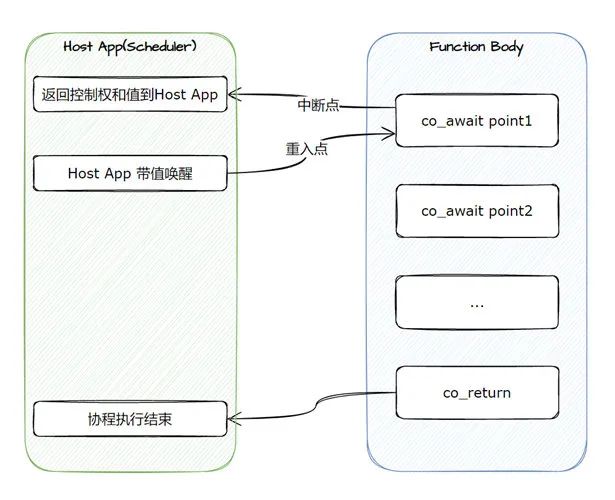
有栈协程和无栈协程定义中断点和重入点的方式和机制略有差异, 执行到中断点和重入点的时候大家使用的保存和恢复机制不太一样, 但以 Host App 的视角来看, 整体的执行过程其实是比较一致的.
这里我们是以 C++20 的无栈协程来举例的, 通过图中的关键字co_await, 我们定义了 point1 和 point2 两个成对的中断点和重入点.
我们来看一下协程执行到中断点和重入点的时候具体发生的事情:中断点:协程中断执行的时候, 我们需要对当前的执行状态:
重入点:重入点是由中断点带出来的概念, 既然函数的执行能够被中断(suspend), 那我们肯定也需要提供机制相关的机制恢复协程的执行了, 在复杂执行的时候, 我们需要对协程保存的执行状态进行恢复:
整个协程的执行区别于普通函数的单次执行返回结果, 一般都会有多次的中断与重入, 直到协程执行完成或者被外界强行中止.
而有栈协程和无栈协程的实现, 差异最大的地方就是如下两点了:
其实之前介绍 C++协程历史的时候, 我们有一个问题没有展开, 为啥有了像 libco, 与 boost.context 这样的高性能有栈协程实现机制后, 标准委员会还会继续寻求无栈协程的解决方案, 并最终将其作为 C++协程的实现机制呢, 这里分析主要的原因是为了解决有栈协程天然存在的限制:
而无栈协程解决这些问题的方式也非常直接, 既然栈会导致问题, 那么我们就直接去除对栈的依赖, 通过其他方式来解决数据存储访问的问题.
目前主要的方案是如下两种:
我们后面介绍的 C++17 的实现就是基于这种方案, 因为仅仅是框架级的实现, 我们能够使用的实现方式会受到限制, 方案本身存在如栈变量的使用有严格的限制等问题, 但对于一些特殊的场合, 如基于寄存器实现的 lua vm, 这种方式会比较契合.
通过后面的分析, 我们其实会发现这与 Duff Device Hack 实现是一脉相承的, 只是通过 compiler 的配合, 像栈变量的自动处理等机制, 保证了用户可以低心智负担的使用它. 但同时, 相对其他语言的实现, 因为相关特性的设计是"面向库作者的实现", 实际使用基本都需要二次封装, 也就带来了社区很多负面的声音.
前面我们对 C++中协程的历史做了简单的铺垫, 接下来我们将对 C++17 中基于 Duff Device Hack 的无栈协程实现, 以及 C++20 中的无栈协程做更深入的介绍.
在异步操作比较多的情况下, 我们就考虑用协程来取代原来的 Callback 设计. 但当时的 GCC 用的是 8.3 版本, 并不支持 coroutine20, 所以我们最终采用的是一个基于 C++17 的无栈协程实现方案, 也就是使用前面介绍的 Duff Device Hack 方式实现的无栈协程. 我们先来看下当时的项目背景.
当时的情况也比较简单, R 工作室内有多个项目处于预研的状态, 所以大家打算协同共建一个工作室内的后台 C++ Framework, 用于工作室内几个预研项目中. 其中比较重要的一部分就是协程了, 当时引入协程的方式和目的都比较直接, 首先是使用 Duff Device Hack 的机制来实现整个无栈协程. 另外就是整个核心目标是希望通过引入协程和相关的调度器来帮助简化多节点的异步编程支持. 整个框架包含的几大部分如下图所示, Coroutine 机制以及相关的 Scheduler 封装是在 app_service 中作为 C++微服务的基础设施存在的.
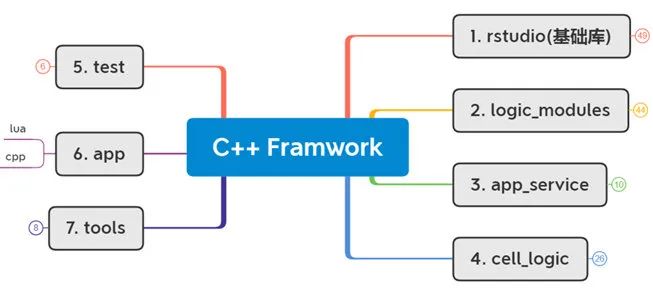
我们为什么先从 C++17 的无栈协程开始介绍, 这是因为 C++17 的实现与 20 的实现一脉相承. 如果我们分析 C++ 20 通过 Compiler 加工后的代码, 就会发现这点. 相比于 C++20 协程大量的细节隐藏在 Compiler 的处理中(当然我们后面也会介绍怎么查看 Compiler 处理的这部分逻辑), C++17 的方案, 整个组织都在我们自己的代码层面, 用于理解无栈协程的整体实现显然是更合适的. 另外, 相关的调度器的实现, 与 C++17 和 C++20 都是兼容的, 像我们项目当时的实现, 是可以很好的做到 C++20 与 C++17 的协程混用的, 也样也方便在过渡阶段, 项目可以更平滑的从 C++17 向 C++20 迁移. 另外, 对于一些不支持 C++20 的受限使用场景, C++17 依然具有它的实用性.
我们先来看一下整个机制的概览图:
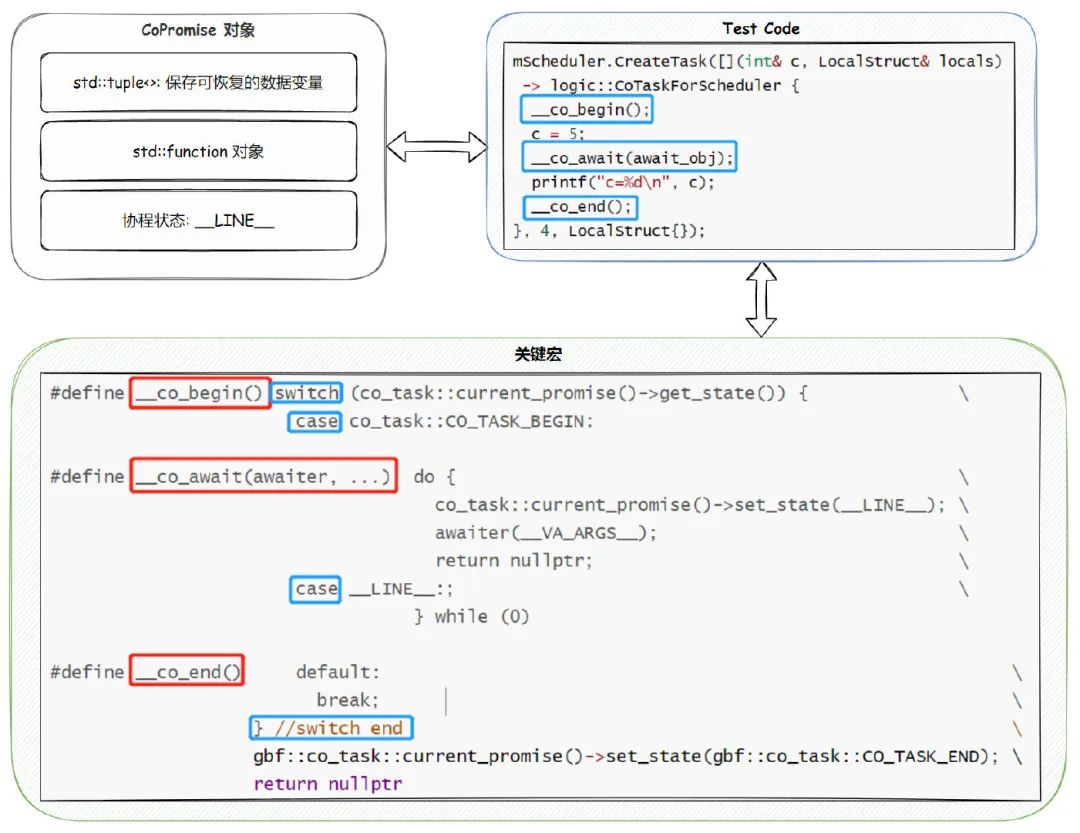
另外, 整个核心的执行机制是依赖于几个核心宏所组成的 switch case 状态机来驱动的. 结合上特殊的LINE宏, 我们可以在每个co_await()对象调用的时候, 设置 CoPromise 对象当前的执行状态为LINE**, 而下次跳转的时候, 通过 switch(state)就能正确跳转到上次执行中断的地方继续往下执行了. 当然, 我们会看到我们的case **LINE**其实被穿插到了do{ } while(0)中间, 这个其实就利用到了 duff device 特性, 允许你通过 case 快速的跳转到 for 循环或者 while 循环的内部, C 语言一个很特殊的特性. 利用这点, 首先我们可以完成**co_awiat()宏的封装, 其次, 我们也能在逻辑代码的 for 循环以及 while 循环中, 正确的应用 co_await(), 所以说 Duff Device 特性对于整个机制来说, 还是比较关键的.
如上例中所述的 Test Code 代码, co_begin()和co_end()展开后构成了 switch() {}的开始和结束部分, 而中间我们加入的__co_await()宏, 则会展开成用于完成中断点和重入点的 case 逻辑, 整体的封装还是很巧妙的.
整体的执行流程通过上面的分析我们也能比较简单的整理出来:
从整体机制上, 我们也能简单看到 C++17 对应实现的一些限制:
mScheduler.CreateTask([](int& c, LocalStruct& locals) -> logic::CoTaskForScheduler {
rco_begin();
{
locals.local_i = 1024;
auto* task = rco_self_task();
printf("step1 %d\n", locals.local_i);
}
rco_yield_next_frame();
{
c = 0;
while(c < 5) {
printf("in while loop c = %d\n", c);
rco_yield_sleep(1000);
c++;
}
rco_yield_next_frame();
}
rco_end();
}, 3, LocalStruct{});从上例可以看出, 虽然存在上一节中我们提到的一些限制, 依照设定的规则进行编码实现, 整体使用还是比较简单易懂的. 上面的 rco_yield_next_frame()和 rco_yield_sleep()是利用 Scheduler 的调度能力封装出来的挂起到下一帧继续恢复执行和休眠这两个异步操作语义.
提到栈变量的限制, 肯定有同学会想到, 是否有方法绕开栈变量的限制, 用一种更灵活的方式处理协程中临时值的存取, 使其在跨越中断点和重入点的情况依然有效?
答案是肯定的. 因为我们有明确的与协程关联的状态存储对象 CoPromise, 所以如果框架中有实现反射或者适应任意类型值存取的类型擦除机制, 我们当然能够很简单的对原有的实现进行扩展.
在 rstudio 的框架实现中, 我们通过在 CoPromise 对象上多存储一个额外的std::map<std::string, reflection::Value>的成员, 再配合适当的包装, 就很容易实现如下示例代码所展示的功能了:
rco_begin();
{
rco_set_value("id", 35567);
}
rco_yield_next_frame();
{
{
int64_t& val = rco_ref_value("id", int64_t);
val = 5;
}
locals.local_i = rco_to_value("id", int);
}
rco_end();通过额外扩展的rco_set_value(), rco_ref_value(), rco_to_value(), 我们即完成了一个比较简单易用的通过 name 对各类型值进行存取的实现, 当然, 实际操作的其实都是在 CoPromise 上存储的std::map<std::string, reflection::Value>成员. 这块是反射的一个简单应用, 关于类型擦除的细节, 与本篇关联不大, 这里不进行具体的展开了.
本章的结尾我们以一个具体的业务实例作为参考, 方便大家了解相关的实现在具体业务中的大致工作情形.
一个原来参与的项目的后台服务器是多节点的设计, 对于切场景来说, 需要访问多个节点来完成相关的操作, 大致的切场景时序图如下所示:
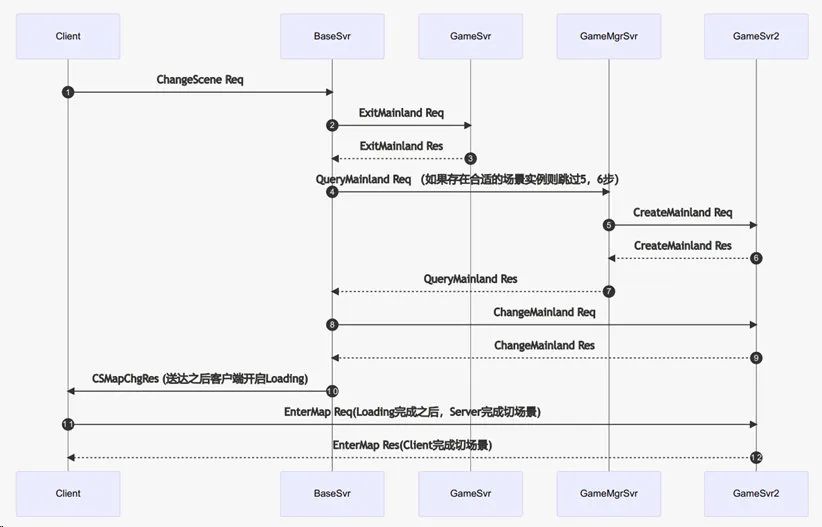
rco_begin();
{
locals.clientReq = req;
locals.session = CServerUtil::GetSessionObj(sessionId);
// ...
SSTbusppInstanceKey emptyInstKey;
emptyInstKey.Init();
if (locals.session->GetTargetGameSvrID() != emptyInstKey) {
// ...
rco_await(locals.gameSceneService->CheckChangeScene(locals.playerId, locals.checkChangeSceneReq));
// ...
// 保存大世界信息
// ...
rco_await(locals.gameSceneService->ExitMainland(locals.playerId, locals.exitMainlandReq));
// ...
}
auto gameMgrClient = GServer->GetRpcClient(TbusppInstanceKey{TBUSPP_SERVER_GAMEMGRSVR, ""});
locals.gameMgrService = rstudio::rpc_proxy::GameMgrService_Proxy::Create(gameMgrClient, GServer->GetRpcScheduler());
// ...
LOG_DEBUG(locals.playerId, "[CHANGE SCENE] ready to Queryline group");
}
rco_await(locals.gameMgrService->QueryMainland2(locals.playerId, locals.querySpaceReq));
{
// ...
rco_await(locals.gameSceneService->ChangeMainland(locals.playerId, locals.localInstanceKey, locals.changeMainlandReq));
// ...
}
// ...
LOG_DEBUG(locals.playerId, "[CHANGE SCENE] send change mainland_conf");
rco_emit_finish_event(rstudio::logic::CoRpcFinishEvent(rstudio::reflection::Value(locals.clientRes)));
rco_return;
rco_end();通过 rco_await()发起的多个异步 Rpc 调用, 我们很好的完成了上述时序图对应的逻辑功能实现.
Rpc 相关的协程化封装在 C++20 中会有个相关的示例, 此处就不重复展开 C++17 的实现了.
了解了 C++17 的 Stackless Coroutine 实现机制后, 我们接着来看一下 C++20 Coroutine 的实现. 首先我们先来通过核心对象概览图来简单了解一下 C++20 Coroutine:
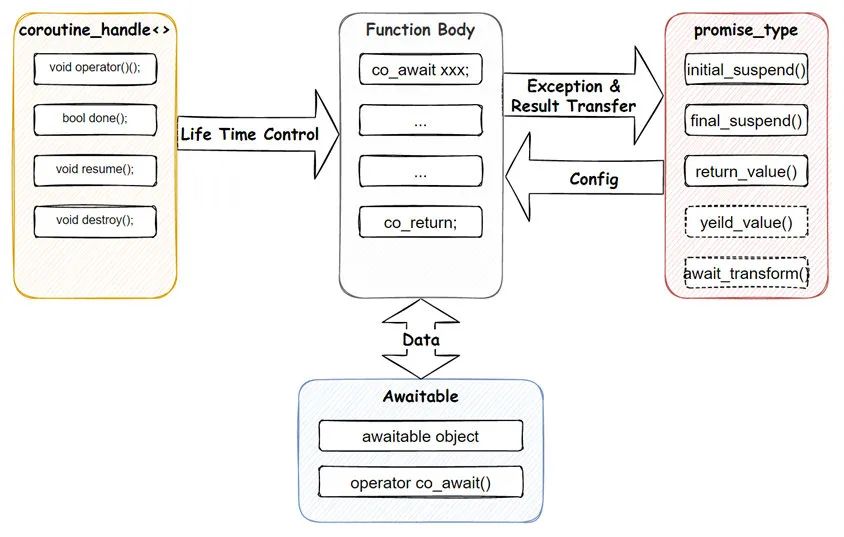
co_await 关键字, 我们就能借助 compiler 实现正确的中断, 重入语义了.从图上也能看到, 对比其它语言较精简的 Coroutine 实现, C++20 这套实现, 还是偏复杂的, 这也是我们常调侃的 "库作者向" 实现, 虽然整体使用很灵活, 也能跟泛型很好的搭配, 但我们还是需要在框架层做大量的包装, 同时业务一般需要一个地方对应用中所有的协程做管理, 方便监控应用的整体运行情况等, 这也使得 C++这套特性没法很简单的直接在业务侧进行使用, 后续我们讲到 Coroutine Scheduler 的时候会进一步展开相关的内容.
此处我们只需要对 Coroutine 的核心对象的构成和作用有个简单的认知, 接下来我们会结合相关的示例代码来深入了解 C++20 Coroutine 的整体运作机制, 了解更多细节.
#include <iostream>
#include <coroutine>
using namespace std;
struct resumable_thing
{
struct promise_type
{
resumable_thing get_return_object()
{
return resumable_thing(coroutine_handle<promise_type>::from_promise(*this));
}
auto initial_suspend() { return suspend_never{}; }
auto final_suspend() noexcept { return suspend_never{}; }
void return_void() {}
void unhandled_exception() {}
};
coroutine_handle<promise_type> _coroutine = nullptr;
resumable_thing() = default;
resumable_thing(resumable_thing const&) = delete;
resumable_thing& operator=(resumable_thing const&) = delete;
resumable_thing(resumable_thing&& other)
: _coroutine(other._coroutine) {
other._coroutine = nullptr;
}
resumable_thing& operator = (resumable_thing&& other) {
if (&other != this) {
_coroutine = other._coroutine;
other._coroutine = nullptr;
}
}
explicit resumable_thing(coroutine_handle<promise_type> coroutine) : _coroutine(coroutine)
{
}
~resumable_thing()
{
if (_coroutine) { _coroutine.destroy(); }
}
void resume() { _coroutine.resume(); }
};
resumable_thing counter() {
cout << "counter: called\n";
for (unsigned i = 1; ; i++)
{
co_await std::suspend_always{};
cout << "counter:: resumed (#" << i << ")\n";
}
}
int main()
{
cout << "main: calling counter\n";
resumable_thing the_counter = counter();
cout << "main: resuming counter\n";
the_counter.resume();
the_counter.resume();
the_counter.resume();
the_counter.resume();
the_counter.resume();
cout << "main: done\n";
return 0;
}从上面的代码我们也能看出, 虽然协程函数 counter()的定义是简单的, 使用也是简单的, 但其实包含promise_type定义的resumable_thing的定义并不简单, 相比其他语言, C++的使用明显复杂很多.
相关代码的输出如下:
main: calling counter
counter: called
main: resuming counter
counter: resumed (#1)
counter: resumed (#2)
counter: resumed (#3)
counter: resumed (#4)
counter: resumed (#5)
main: done前面我们说过, C++17 下对应的实现机制大致如下:

这其实也是 C++20 Coroutine 使用的一大难点, 除了前文提到的, 特性通过 Awaitable 定制点开放给你的地方, 整体的运作机制, 我们是很难直接得出的. 另外, 在一些多线程协程混用的复杂情况下, 整体运作机制对于我们实现正确的框架, 正确的分析解决碰到的问题至关重要. 那么我们现在的问题就变成了, 怎么去补全出包含编译器处理的整体代码?
因为 C++各种复杂的 compiler 处理机制, 已经有相关的 compiler 预处理分析的工具被开发出来了, 我们这里用的是一个叫 cppinsights 的工具, 这是一个基于 web 的工具, 所以我们打开网页即可使用它, 网址是 cppinsights.io 工具的截图如下:
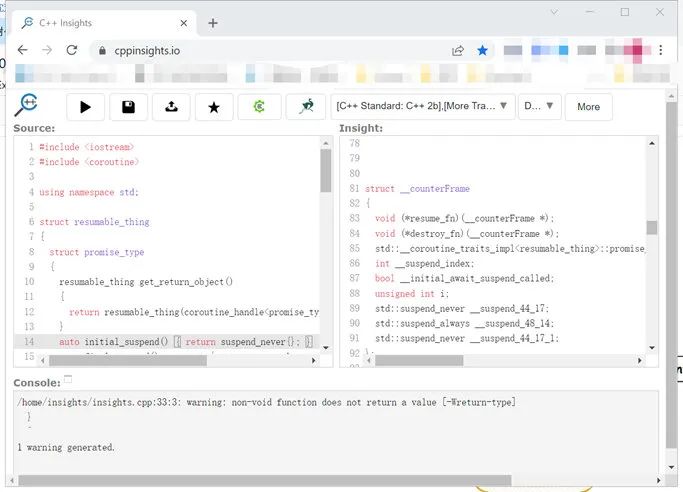
cppinsights本身是基于 clang 的, 提供了多种 clang compiler 预处理信息的查看, 比如我们现在需要用到的 coroutine transformation:
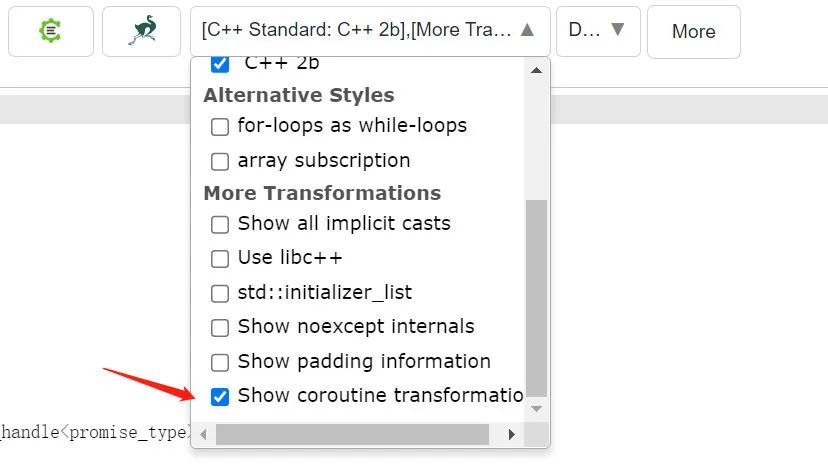
cppinsights处理后生成的代码如下:
/*************************************************************************************
* NOTE: The coroutine transformation you've enabled is a hand coded transformation! *
* Most of it is _not_ present in the AST. What you see is an approximation. *
*************************************************************************************/
#include <iostream>
#include <coroutine>
using namespace std;
struct resumable_thing
{
struct promise_type
{
inline resumable_thing get_return_object()
{
return resumable_thing(resumable_thing(std::coroutine_handle<promise_type>::from_promise(*this)));
}
inline std::suspend_never initial_suspend()
{
return std::suspend_never{};
}
inline std::suspend_never final_suspend() noexcept
{
return std::suspend_never{};
}
inline void return_void()
{
}
inline void unhandled_exception()
{
}
// inline constexpr promise_type() noexcept = default;
};
std::coroutine_handle<promise_type> _coroutine;
inline constexpr resumable_thing() /* noexcept */ = default;
// inline resumable_thing(const resumable_thing &) = delete;
// inline resumable_thing & operator=(const resumable_thing &) = delete;
inline resumable_thing(resumable_thing && other)
: _coroutine{std::coroutine_handle<promise_type>(other._coroutine)}
{
other._coroutine.operator=(nullptr);
}
inline resumable_thing & operator=(resumable_thing && other)
{
if(&other != this) {
this->_coroutine.operator=(other._coroutine);
other._coroutine.operator=(nullptr);
}
}
inline explicit resumable_thing(std::coroutine_handle<promise_type> coroutine)
: _coroutine{std::coroutine_handle<promise_type>(coroutine)}
{
}
inline ~resumable_thing() noexcept
{
if(static_cast<bool>(this->_coroutine.operator bool())) {
this->_coroutine.destroy();
}
}
inline void resume()
{
this->_coroutine.resume();
}
};
struct __counterFrame
{
void (*resume_fn)(__counterFrame *);
void (*destroy_fn)(__counterFrame *);
std::__coroutine_traits_impl<resumable_thing>::promise_type __promise;
int __suspend_index;
bool __initial_await_suspend_called;
unsigned int i;
std::suspend_never __suspend_44_17;
std::suspend_always __suspend_48_14;
std::suspend_never __suspend_44_17_1;
};
resumable_thing counter()
{
/* Allocate the frame including the promise */
__counterFrame * __f = reinterpret_cast<__counterFrame *>(operator new(__builtin_coro_size()));
__f->__suspend_index = 0;
__f->__initial_await_suspend_called = false;
/* Construct the promise. */
new (&__f->__promise)std::__coroutine_traits_impl<resumable_thing>::promise_type{};
resumable_thing __coro_gro = __f->__promise.get_return_object() /* NRVO variable */;
/* Forward declare the resume and destroy function. */
void __counterResume(__counterFrame * __f);
void __counterDestroy(__counterFrame * __f);
/* Assign the resume and destroy function pointers. */
__f->resume_fn = &__counterResume;
__f->destroy_fn = &__counterDestroy;
/* Call the made up function with the coroutine body for initial suspend.
This function will be called subsequently by coroutine_handle<>::resume()
which calls __builtin_coro_resume(__handle_) */
__counterResume(__f);
return __coro_gro;
}
/* This function invoked by coroutine_handle<>::resume() */
void __counterResume(__counterFrame * __f)
{
try
{
/* Create a switch to get to the correct resume point */
switch(__f->__suspend_index) {
case 0: break;
case 1: goto __resume_counter_1;
case 2: goto __resume_counter_2;
}
/* co_await insights.cpp:44 */
__f->__suspend_44_17 = __f->__promise.initial_suspend();
if(!__f->__suspend_44_17.await_ready()) {
__f->__suspend_44_17.await_suspend(std::coroutine_handle<resumable_thing::promise_type>::from_address(static_cast<void *>(__f)).operator coroutine_handle());
__f->__suspend_index = 1;
__f->__initial_await_suspend_called = true;
return;
}
__resume_counter_1:
__f->__suspend_44_17.await_resume();
std::operator<<(std::cout, "counter: called\n");
for( __f->i = 1; ; __f->i++) {
/* co_await insights.cpp:48 */
__f->__suspend_48_14 = std::suspend_always{};
if(!__f->__suspend_48_14.await_ready()) {
__f->__suspend_48_14.await_suspend(std::coroutine_handle<resumable_thing::promise_type>::from_address(static_cast<void *>(__f)).operator coroutine_handle());
__f->__suspend_index = 2;
return;
}
__resume_counter_2:
__f->__suspend_48_14.await_resume();
std::operator<<(std::operator<<(std::cout, "counter:: resumed (#").operator<<(__f->i), ")\n");
}
goto __final_suspend;
} catch(...) {
if(!__f->__initial_await_suspend_called) {
throw ;
}
__f->__promise.unhandled_exception();
}
__final_suspend:
/* co_await insights.cpp:44 */
__f->__suspend_44_17_1 = __f->__promise.final_suspend();
if(!__f->__suspend_44_17_1.await_ready()) {
__f->__suspend_44_17_1.await_suspend(std::coroutine_handle<resumable_thing::promise_type>::from_address(static_cast<void *>(__f)).operator coroutine_handle());
}
;
}
/* This function invoked by coroutine_handle<>::destroy() */
void __counterDestroy(__counterFrame * __f)
{
/* destroy all variables with dtors */
__f->~__counterFrame();
/* Deallocating the coroutine frame */
operator delete(__builtin_coro_free(static_cast<void *>(__f)));
}
int main()
{
std::operator<<(std::cout, "main: calling counter\n");
resumable_thing the_counter = counter();
std::operator<<(std::cout, "main: resuming counter\n");
the_counter.resume();
the_counter.resume();
the_counter.resume();
the_counter.resume();
the_counter.resume();
std::operator<<(std::cout, "main: done\n");
return 0;
}
cppinsights 本身也跟 Compiler Explorer 做了拉通, 做代码深度分析的时候, 更多的结合这些开源工具, 很多时候还是非常有帮助的.
那么有了 compiler 预处理后的代码, 再来分析 C++20 Coroutine 的机制, 就变得简单了.
对于 compiler 预处理后的代码, 我们直接结合结构图来分析:

__coutnerResume()中, 然后出现了一个编译器帮我们定义的对象__couterFrame, 通过分析代码很容易知道, __counterFrame结构主要完成几部分的事情:
__suspend_index来记录的.当我们观察__counterResume()的实现, 有趣的事情来了, 我们发现, 其实 C++20 也是使用一个大的 switch-case 来作为协程执行的全局状态机, 只不过每个 case lablel 后面, 接的是 goto, 而不是像我们在 C++17 下面那样, 直接嵌入的业务代码.
整体 C++20 的实现思路, 基本上与 17 的实现思路是一脉相承的, 只不过得益于 compiler 的支持, 很多事情我们都由主动处理 -> 自动处理.
couter() - Function Body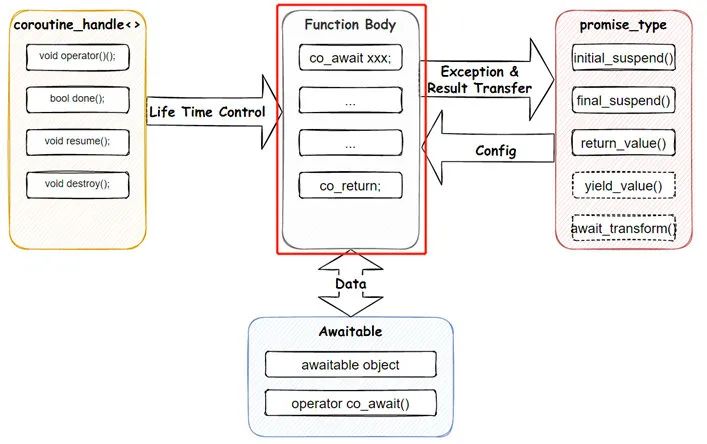
couter()会被编译器改写, 最终其实是变成了三个函数:
__counterFrame对象的counter(), 只是一个协程入口函数.__counterResume()函数, 它的输入参数就是__counterFrame对象.**counterDestroy()函数.通过一拆三, 编译器很好的解决了协程的入口, 协程的中断重入, 和协程以及相关对象的销毁的问题.
coroutine_handle<>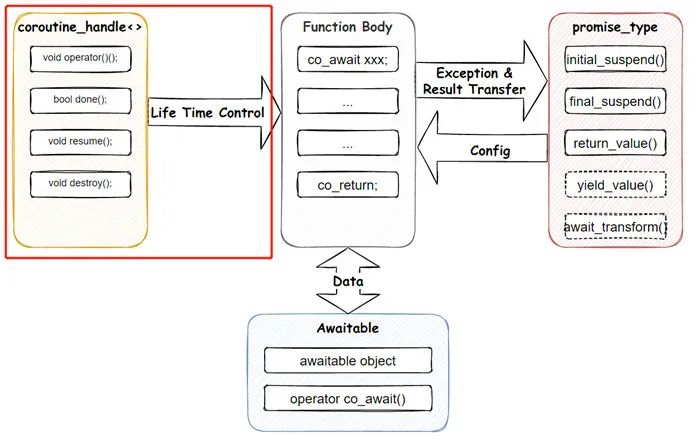
coroutine_handle<>的定义代码如下
template <> struct coroutine_handle<void>{
constexpr coroutine_handle() noexcept;
constexpr coroutine_handle(nullptr_t) noexcept;
coroutine_handle& operator=(nullptr_t) noexcept;
constexpr void* address() const noexcept;
constexpr static coroutine_handle from_address(void* addr);
constexpr explicit operator bool() const noexcept;
bool done() const;
void operator()();
void resume();
void destroy();
private:
void* ptr;// exposition only
};我们结合前面展开的代码, 已经很好理解coroutine_handle<>为何会有协程生命周期控制的能力了, 因为它关联了xxxFrame对象, 而通过前面的分析, xxxFrame的是虚表记录了协程 resume 和 destroy 的函数, 所以这个地方的 ptr, 其实就是一个xxxFrame对象, 正确的关联了xxxFrame对象, 透过它, 我们自然能够拥有resume(), destroy()等一系列的能力了, 这里并没有任何魔法的存在.
template <typename Promise>
struct coroutine_handle
: coroutine_handle<void>
{
Promise& promise() const noexcept;
static coroutine_handle from_promise(Promise&) noexcept;
};另外通过继承的方式, coroutine_handle<>完成了与 Promise 对象关联和转换的功能.
promise_type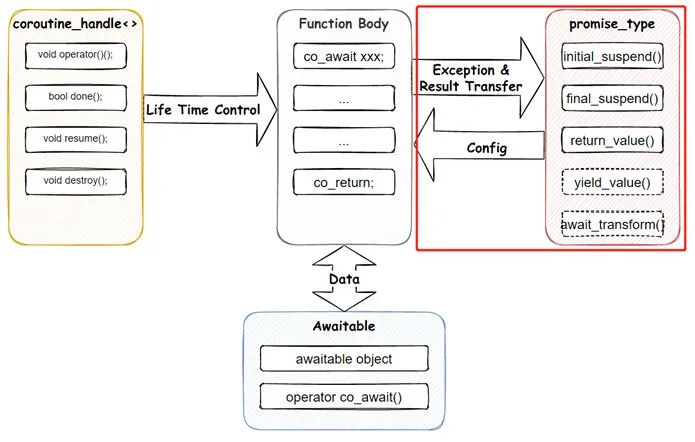
/* This function invoked by coroutine_handle<>::resume() */
void __counterResume(__counterFrame * __f)
{
try
{
/* Create a switch to get to the correct resume point */
switch(__f->__suspend_index) {
case 0: break;
case 1: goto __resume_counter_1;
case 2: goto __resume_counter_2;
}
/* initial suspend handle here~~ */
__f->__suspend_44_17 = __f->__promise.initial_suspend();
__resume_counter_1:
/* do somthing for yield~~ */
__resume_counter_2:
/* do somthing for resume~~ */
goto __final_suspend;
} catch(...) {
if(!__f->__initial_await_suspend_called) {
throw ;
}
__f->__promise.unhandled_exception();
}
__final_suspend:
/* final suspend here~~ */
__f->__suspend_44_17_1 = __f->__promise.final_suspend();
}通过__counterResume()的逻辑实现, promise 为何可以对协程的初始化和结束行为进行控制, 也很一目了然了, 因为__counterFrame对象中关联了我们定义的promise_type类型, 所以我们也能很直接的通过__counterFrame访问到promise_type类型, 一方面充当配置项的角色, 如控制initial_suspend, final_suspend. 另外, promise_type也作为一个 Wrapper, 对如co_yield等进行转义执行, 以及异常的转发处理, 也是非常好理解的机制.

std:suspend_alwaysstd::suspend_never另外我们也能通过多种方式定义 awaitable 对象:promise_type的await_transform() - 这是 asio 所使用的方式, 侵入性比较强operator co_await()await_ready(), await_suspend(), await_resume() - 推荐的方式 那么当我们调用co_await awaitable的时候, 发生的事情是什么呢, 我们同样通过预处理的代码来进行了解:__resume_counter_1:
__f->__suspend_44_17.await_resume();
std::operator<<(std::cout, "counter: called\n");
for( __f->i = 1; ; __f->i++) {
/* co_await insights.cpp:48 */
__f->__suspend_48_14 = std::suspend_always{};
if(!__f->__suspend_48_14.await_ready()) {
__f->__suspend_48_14.await_suspend(coroutine_handle);
__f->__suspend_index = 2;
return;
}
__resume_counter_2:
__f->__suspend_48_14.await_resume();
std::cout << "counter:: resumed (#" << __f->i << ")\n";
}对于每一次的co_await, 编译器处理后的代码, 都会形成一个中断点 和一个重入点, 其实对应的是两个状态, 刚开始执行的时候, 进入的是中断点的逻辑, 也就是我们看到的__resume_counter_1对应 label 的代码, 而重入点则是__resume_counter_2对应 label 的代码, 结合此处展开的实例代码, 我们也能很好的理解 awaitable 三个子函数的具体作用了:
await_ready() - 判断是否需要挂起, 如不需要挂起, 则直接执行后续逻辑, 这里也就是继续到__resume_counter_2这个 label 执行重入点的逻辑await_suspend() - 中断点触发的时候执行的逻辑, 业务中我们一般在此处发起异步操作await_resume() - 重入点触发的时候执行的逻辑. 整体的机制是不是清晰了很多?我们总结 C++20 协程的特点:
co_await支持的业务, 这种实现侵入性低, 实际使用负担小前面我们也提到了, 要做到 "库作者向特性" => 面向业务的异步框架, 我们还需要一些额外的工作, 这就是我们马上要介绍的 Coroutine Scheduler - 协程调度器.
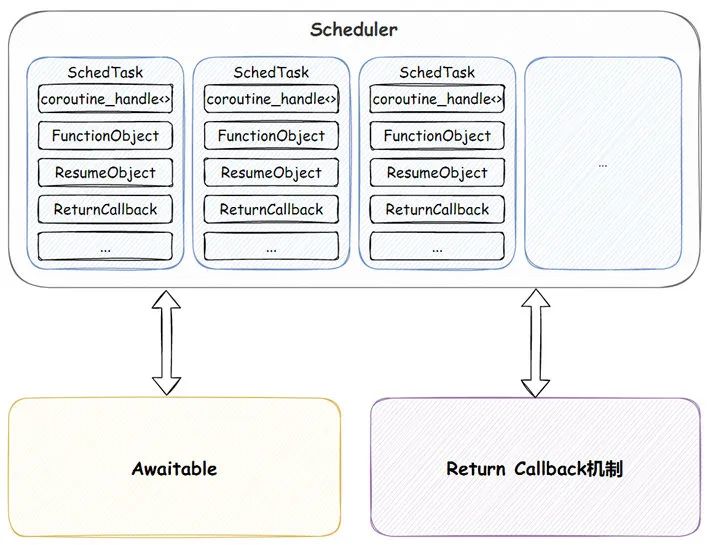
using CoReturnFunction = std::function<void(const CoReturnObject*)>;
class ISchedTask
{
friend class Scheduler;
public:
ISchedTask() = delete;
ISchedTask(const SchedTaskCpp17&) = delete;
ISchedTask(uint64_t taskId, Scheduler* manager);
virtual ~ISchedTask();
uint64_t GetId() const;
virtual int Run() = 0;
virtual bool IsDone() const = 0;
virtual CO_TASK_STATE GetCoState() const = 0;
void BindSleepHandle(uint64_t handle);
AwaitMode GetAwaitMode() const;
int GetAwaitTimeout() const;
template<typename AwaitEventType>
auto BindResumeObject(AwaitEventType&& awaitEvent)->std::enable_if_t<std::is_base_of<ResumeObject, AwaitEventType>::value>;
template<typename AwaitEventType>
auto GetResumeObjectAsType()->std::enable_if_t<std::is_base_of<ResumeObject, AwaitEventType>::value, AwaitEventType*>;
bool HasResumeObject() const noexcept;
void ClearResumeObject();
bool IsLastInvokeSuc() const noexcept;
bool IsLastInvokeTimeOut() const noexcept;
bool IsLastInvokeFailed() const noexcept;
void AddChildTask(uint64_t tid);
void AddWaitNofityTask(uint64_t tid);
const auto& GetChildTaskArray() const;
const auto& GetWaitNotifyArray() const;
void Terminate();
Scheduler* GetManager() const;
static ISchedTask* CurrentTask();
void DoYield(AwaitMode mode, int awaitTimeMs = 0);
void SetReturnFunction(CoReturnFunction&& func);
void DoReturn(const CoReturnObject& obj);
void DoReturn();
protected:
uint64_t mTaskId;
Scheduler* mManager;
std::vector<uint64_t> mChildArray;
std::vector<uint64_t> mWaitNotifyArray;
//value used to return from coroutine
AwaitMode mAwaitMode = AwaitMode::AwaitDoNothing;
int mAwaitTimeout = 0;
//value used to send to coroutine(now as a AwaitEvent)
reflection::UserObject mResumeObject;
uint64_t mSleepHandle = 0;
bool mIsTerminate = false;
CoReturnFunction mCoReturnFunc;
};
class SchedTaskCpp20: public ISchedTask
{
public:
SchedTaskCpp20(uint64_t taskId, CoTaskFunction&& taskFunc, Scheduler* manager);
~SchedTaskCpp20();
int Run() override;
bool IsDone() const override;
CO_TASK_STATE GetCoState() const override;
void BindSelfToCoTask();
const CoResumingTaskCpp20& GetResumingTask() const;
protected:
CoResumingTaskCpp20 mCoResumingTask;
CoTaskFunction mTaskFuncion;
};C++20 的 SchedTaskCpp20 主要完成对协程对象的封装, CoTaskFunction 用于存储相关的函数对象, 而 CoResumingTaskCpp20 则如同前面示例中的 resumable_thing 对象,内部有需要的 promise_type 实现, 我们对协程的访问也是通过它来完成的。
此处需要注意的是我们保存了协程对象外, 还额外保存了相关的函数对象, 这是因为如果协程本身是一个 lambda, compiler 并不会帮我们正确维护 lambda 的生命周期以及 lambda 所捕获的函数, 尚未清楚是实现缺陷还是功能就是如此, 所以此处需要一个额外存在的 std::function<>对象, 来保证对应 lambda 的生命周期是正确的。
对比 17 的实现, 我们的 SchedTask 对象中主要保留了:reflection::UserObject mResumeObject: 主要用于异步等待的执行, 当一个异步等待成功执行的时候, 向协程传递值。
原来利用事件去处理最终返回值的机制也替换成了 Return 回调的方式,相对来说更简单直接, 利用 lambda 本身也能很方便的保存需要最终回传的临时值了。
Scheduler 的代码比较多, 主要就是 SchedTask 的管理器, 另外也完成对前面提到的三种机制的支持, 文章重点分析一下三种机制的实现代码.
void Scheduler::Update()
{
RSTUDIO_PROFILER_METHOD_INFO(sUpdate, "Scheduler::Update()", rstudio::ProfilerGroupType::kLogicJob);
RSTUDIO_PROFILER_AUTO_SCOPE(sUpdate);
//Handle need kill task first
while(!mNeedKillArray.empty())
{
auto tid = mNeedKillArray.front();
mNeedKillArray.pop();
auto* tmpTask = GetTaskById(tid);
if (tmpTask != nullptr)
{
DestroyTask(tmpTask);
}
}
//Keep a temp queue for not excute next frame task right now
decltype(mFrameStartTasks) tmpFrameTasks;
mFrameStartTasks.swap(tmpFrameTasks);
while (!tmpFrameTasks.empty())
{
auto task_id = tmpFrameTasks.front();
tmpFrameTasks.pop();
auto* task = GetTaskById(task_id);
LOG_CHECK_ERROR(task);
if (task)
{
AddToImmRun(task);
}
}
}
void Scheduler::AddToImmRun(ISchedTask* schedTask)
{
LOG_PROCESS_ERROR(schedTask);
schedTask->Run();
if (schedTask->IsDone())
{
DestroyTask(schedTask);
return;
}
{
auto awaitMode = schedTask->GetAwaitMode();
auto awaitTimeoutMs = schedTask->GetAwaitTimeout();
switch (schedTask->GetAwaitMode())
{
case rstudio::logic::AwaitMode::AwaitNever:
AddToImmRun(schedTask);
break;
case rstudio::logic::AwaitMode::AwaitNextframe:
AddToNextFrameRun(schedTask);
break;
case rstudio::logic::AwaitMode::AwaitForNotifyNoTimeout:
case rstudio::logic::AwaitMode::AwaitForNotifyWithTimeout:
{
HandleTaskAwaitForNotify(schedTask, awaitMode, awaitTimeoutMs);
}
break;
case rstudio::logic::AwaitMode::AwaitDoNothing:
break;
default:
RSTUDIO_ERROR(CanNotRunToHereError());
break;
}
}
Exit0:
return;
}上面是 Scheduler 的 Update()以及 Update 用到的核心函数 AddToImmRun()的实现代码, 在每个 task->Run()后, 到达下一个挂起点, 返回外部代码的时候, 外部代码会根据 Task 当前的 AwaitMode 对协程后续行为进行控制, 主要是以下几种模式:
Resume 机制主要是通过唤醒在 Await 队列中的协程的时候向关联的 Task 对象传递 ResumeObject 实现的:
//Not a real event notify here, just do need things
template <typename E>
auto ResumeTaskByAwaitObject(E&& awaitObj)
-> std::enable_if_t<std::is_base_of<ResumeObject, E>::value>
{
auto tid = awaitObj.taskId;
if (IsTaskInAwaitSet(tid))
{
//Only in await set task can be resume
auto* task = GetTaskById(tid);
if (RSTUDIO_LIKELY(task != nullptr))
{
task->BindResumeObject(std::forward<E>(awaitObj));
AddToImmRun(task);
}
OnTaskAwaitNotifyFinish(tid);
}
}然后再通过 rco_get_resume_object()宏在协程代码中获取对应的 ResumeObject. 宏的声明代码如下:
#define rco_get_resume_object(ResumeObjectType) rco_self_task()->GetResumeObjectAsType<ResumeObjectType>()
本身就是一个简单的传值取值的过程. 注意传递 ResumeObject 后, 我们也会马上将协程加入到 mReadTasks 队列中以方便在接下来的 Update 中唤醒它.
我们以 Rpc 的协程化 Caller 实现为例, 看看一个 awaitable 对象应该如何构造:
class RSTUDIO_APP_SERVICE_API RpcRequest
{
public:
RpcRequest() = delete;
////RpcRequest(const RpcRequest&) = delete;
~RpcRequest() = default;
RpcRequest(const logic::GameServiceCallerPtr& proxy,
const std::string_view funcName,
reflection::Args&& arg, int timeoutMs) :
mProxy(proxy)
, mFuncName(funcName)
, mArgs(std::forward<reflection::Args>(arg))
, mTimeoutMs(timeoutMs)
{}
bool await_ready()
{
return false;
}
void await_suspend(coroutine_handle<>) const noexcept
{
auto* task = rco_self_task();
auto context = std::make_shared<ServiceContext>();
context->TaskId = task->GetId();
context->Timeout = mTimeoutMs;
auto args = mArgs;
mProxy->DoDynamicCall(mFuncName, std::move(args), context);
task->DoYield(AwaitMode::AwaitForNotifyNoTimeout);
}
::rstudio::logic::RpcResumeObject* await_resume() const noexcept
{
return rco_get_resume_object(logic::RpcResumeObject);
}
private:
logic::GameServiceCallerPtr mProxy;
std::string mFuncName;
reflection::Args mArgs;
int mTimeoutMs;
};重点是前面说到的 await_ready(), await_suspend(), await_resume()函数的实现。
有一些场合, 可能需要协程执行完成后向业务系统发起通知并传递返回值, 比如 Rpc Service 的协程支持实现等, 这个特性其实比较类似 go 的 defer, 只是这里的实现更简单, 只支持单一函数的指定而不是队列. 我们直接以 RpcService 的协程支持为例来看一下这一块的具体使用.
首先是业务侧, 在创建完协程后, 需要给协程绑定后续协程执行完成后做进一步操作需要的数据:
task->SetReturnFunction(
[this, server, entity, cmdHead, routerAddr,
reqHead, context](const CoReturnObject* obj) {
const auto* returnObj = dynamic_cast<const CoRpcReturnObject*>(obj);
if (RSTUDIO_LIKELY(returnObj))
{
DoRpcResponse(server, entity.get(), routerAddr, &cmdHead,
reqHead, const_cast<ServiceContext&>(context),
returnObj->rpcResultType,
returnObj->totalRet, returnObj->retValue);
}
});这里将 Connection id 等信息通过 lambda 的 capture 功能直接绑定到 SchedTask 的返回函数,然后业务代码会利用 co_return 本身的功能向 promise_type 传递返回值:
CoTaskInfo HeartBeatService::DoHeartBeat(
logic::Scheduler& scheduler, int testVal)
{
return scheduler.CreateTask20(
[testVal]() -> logic::CoResumingTaskCpp20 {
co_await logic::cotasks::Sleep(1000);
printf("service yield call finish!\n");
co_return CoRpcReturnObject(reflection::Value(testVal + 1));
}
);
}最终我们利用 promise_type 的 return_value()来完成对设置的回调的调用:
void CoResumingTaskCpp20::promise_type::return_value(const CoReturnObject& obj)
{
auto* task = rco_self_task();
task->DoReturn(obj);
}注意这个地方 task 上存储的 ExtraFinishObject 会作为 event 的一部分直接传递给业务系统, 并在发起事件后调用删除协程任务的方法.
对比原版 17 的 Finish Event 实现, 通过 Return Callback 的方式来对一些特殊的返回进行处理, 这种机制是更容易使用的。
//C++ 20 coroutine
auto clientProxy = mRpcClient->CreateServiceProxy("mmo.HeartBeat");
mScheduler.CreateTask20([clientProxy]()
-> rstudio::logic::CoResumingTaskCpp20 {
auto* task = rco_self_task();
printf("step1: task is %llu\n", task->GetId());
co_await rstudio::logic::cotasks::NextFrame{};
printf("step2 after yield!\n");
int c = 0;
while (c < 5) {
printf("in while loop c=%d\n", c);
co_await rstudio::logic::cotasks::Sleep(1000);
c++;
}
for (c = 0; c < 5; c++) {
printf("in for loop c=%d\n", c);
co_await rstudio::logic::cotasks::NextFrame{};
}
printf("step3 %d\n", c);
auto newTaskId = co_await rstudio::logic::cotasks::CreateTask(false,
[]()-> logic::CoResumingTaskCpp20 {
printf("from child coroutine!\n");
co_await rstudio::logic::cotasks::Sleep(2000);
printf("after child coroutine sleep\n");
});
printf("new task create in coroutine: %llu\n", newTaskId);
printf("Begin wait for task!\n");
co_await rstudio::logic::cotasks::WaitTaskFinish{ newTaskId, 10000 };
printf("After wait for task!\n");
rstudio::logic::cotasks::RpcRequest
rpcReq{clientProxy, "DoHeartBeat", rstudio::reflection::Args{ 3 }, 5000};
auto* rpcret = co_await rpcReq;
if (rpcret->rpcResultType == rstudio::network::RpcResponseResultType::RequestSuc) {
assert(rpcret->totalRet == 1);
auto retval = rpcret->retValue.to<int>();
assert(retval == 4);
printf("rpc coroutine run suc, val = %d!\n", retval);
}
else {
printf("rpc coroutine run failed! result = %d \n", (int)rpcret->rpcResultType);
}
co_await rstudio::logic::cotasks::Sleep(5000);
printf("step4, after 5s sleep\n");
co_return rstudio::logic::CoNil;
} );执行结果:
step1: task is 1
step2 after yield!
in while loop c=0
in while loop c=1
in while loop c=2
in while loop c=3
in while loop c=4
in for loop c=0
in for loop c=1
in for loop c=2
in for loop c=3
in for loop c=4
step3 5
new task create in coroutine: 2
Begin wait for task!
from child coroutine!
after child coroutine sleep
After wait for task!
service yield call finish!
rpc coroutine run suc, val = 4!
step4, after 5s sleep对比 17 的实现, 主要的好处是:
//C++ 20 coroutine
auto clientProxy = mRpcClient->CreateServiceProxy("mmo.HeartBeat");
mScheduler.CreateTask20([clientProxy]()
-> rstudio::logic::CoResumingTaskCpp20 {
auto* task = rco_self_task();
printf("step1: task is %llu\n", task->GetId());
co_await rstudio::logic::cotasks::NextFrame{};
printf("step2 after yield!\n");
int c = 0;
while (c < 5) {
printf("in while loop c=%d\n", c);
co_await rstudio::logic::cotasks::Sleep(1000);
c++;
}
for (c = 0; c < 5; c++) {
printf("in for loop c=%d\n", c);
co_await rstudio::logic::cotasks::NextFrame{};
}
printf("step3 %d\n", c);
auto newTaskId = co_await rstudio::logic::cotasks::CreateTask(false,
[]()-> logic::CoResumingTaskCpp20 {
printf("from child coroutine!\n");
co_await rstudio::logic::cotasks::Sleep(2000);
printf("after child coroutine sleep\n");
});
printf("new task create in coroutine: %llu\n", newTaskId);
printf("Begin wait for task!\n");
co_await rstudio::logic::cotasks::WaitTaskFinish{ newTaskId, 10000 };
printf("After wait for task!\n");
rstudio::logic::cotasks::RpcRequest
rpcReq{clientProxy, "DoHeartBeat", rstudio::reflection::Args{ 3 }, 5000};
auto* rpcret = co_await rpcReq;
if (rpcret->rpcResultType == rstudio::network::RpcResponseResultType::RequestSuc) {
assert(rpcret->totalRet == 1);
auto retval = rpcret->retValue.to<int>();
assert(retval == 4);
printf("rpc coroutine run suc, val = %d!\n", retval);
}
else {
printf("rpc coroutine run failed! result = %d \n", (int)rpcret->rpcResultType);
}
co_await rstudio::logic::cotasks::Sleep(5000);
printf("step4, after 5s sleep\n");
co_return rstudio::logic::CoNil;
} );通过前面的介绍, 我们很容易得出以下几个 C++20 Coroutine 的优势:
co_await可以直接返回对应类型的值, 这样协程本身就有了强制的类型约束, 整体业务的表达也会因为不需要从类型擦除的对象获取需要的类型, 变得更顺畅.我们思考一个问题, 如果部分使用 OOP 进行设计的系统, 使用协程的思路重构, 会是什么样子的?
刚好笔者原来的某个项目是使用 Python 作为脚本, 当时尝试使用 Python 的 Coroutine 实现了一版技能系统, 今天我们来尝试使用 C++20 Coroutine 重新实现它, 这样也能够对比一下, 在有协程调度器存在的情况下, 业务侧对协程的使用感受, 与其他语言如 Python 中的差异.
我们以一个原来在 python 中利用包装的协程调度器实现的技能系统为例, 先来看看相关的实现效果和核心代码。
python 的 stackless 协程实现不是我们关注的重点,参考的第一个链接是相关的实现思路,感兴趣的可以打开相关链接详细了解, 此处就不再展开细说了。
以下是相关实现的示例效果, 主要是一个火球技能和实现和一个闪电链技能的实现:
我们先来看一下技能的主流程代码, 可以发现使用协程方式实现, 整个代码更函数式, 区别于面向对象构造不同对象存储中间态数据的设计。
# handle one skill instance create
def skill_instance_run_func(instance, user, skill_data, target, target_pos, finish_func):
# set return callback here
yield TaskSetExitCallback(finish_func)
# ... some code ignore here
from common.gametime import GameTime
init_time = GameTime.now_time
for skill_step in step_list:
step_start_time = GameTime.now_time
# ... some code ignore here
### 1. period task handle
if skill_step.cast_type == CastSkillStep.CAST_TYPE_PERIOD:
#... some code ignore here
### 2. missle skill
elif skill_step.cast_type == CastSkillStep.CAST_TYPE_MISSLE_TO_TARGET:
if len(skill_step.cast_action_group_list) > 0:
action_group = skill_step.cast_action_group_list[0]
for i in range(skill_step.cast_count):
# yield for sleep
yield TaskSleep(skill_step.cast_period)
ret_val = do_skill_spend(skill_data, user, instance)
if not ret_val:
return
# sub coroutine(missle_handle_func)
task_id = yield TaskNew(missle_handle_func(
skill_data, instance, user, skill_step, action_group, target_id, target_pos))
instance.add_child_task_id(task_id)
### 3. guide skill
elif skill_step.cast_type == CastSkillStep.CAST_TYPE_GUIDE_TO_TARGET:
#... some code ignore here
now_time = GameTime.now_time
step_pass_time = now_time - step_start_time
need_sleep_time = skill_step.step_total_time - step_pass_time
if need_sleep_time > 0:
yield TaskSleep(need_sleep_time)
instance.on_one_step_finish(skill_step)
if skill_data.delay_end_time > 0:
yield TaskSleep(skill_data.delay_end_time)
# wait for child finish~~
for task_id in instance.child_task_list:
yield TaskWait(task_id)
instance.task_id = 0
整体实现比较简单, 整个技能是由多个 SkillStep 来配置的, 整体技能的流程就是 for 循环执行所有 SkillStep, 然后提供了多种 SkillStep 类型的处理, 主要是以下几类:
最后所有 step 应用完毕会进入配置的休眠和等待子任务的阶段。
对于上面介绍的导弹类技能(火球), 核心实现也比较简单, 实现了一个飞行物按固定速度逼近目标的效果, 具体代码如下, 利用 yield 我们可以实现在飞行物未达到目标点的时候每帧执行一次的效果:
### 1. handle for missle skill(etc: fire ball)
def missle_handle_func(skill_data, instance, user, skill_step, action_group, target_id, target_pos):
effect = instance.create_effect(skill_step.missle_info.missle_fx_path)
effect.set_scale(skill_step.missle_info.missle_scale)
cur_target_pos, is_target_valid = skill_step.missle_info.get_target_position(
user, target_id, target_pos)
start_pos = skill_step.missle_info.get_start_position(user, target_id, target_pos)
is_reach_target = False
from common.gametime import GameTime
init_time = GameTime.now_time
while True:
# ... some code ignore here
fly_distance = skill_step.missle_info.fly_speed*GameTime.elapse_time
if fly_distance < total_distance:
start_pos += fly_direction*math3d.vector(fly_distance, fly_distance, fly_distance)
effect.set_position(start_pos)
else:
is_reach_target = True
break
# do yield util next frame
yield
effect.destroy()
if is_reach_target:
target_list = skill_data.get_target_list(user.caster, target_id, target_pos)
for target in target_list:
action_group.do(user.caster, target)对于上面介绍的引导类技能(闪电链),依托框架本身的 guide effect 实现, 我们利用 yield TaskSleep()就能很好的完成相关的功能了:
### 2. handle for guide skill(etc: lighting chain)
def guide_handle_func(skill_data, instance, user, skill_step, start_pos, target_id, target_pos):
effect = instance.create_effect(skill_step.guide_info.guide_fx_path)
effect.set_scale(skill_step.guide_info.guide_scale)
effect.set_position(start_pos)
effect.set_guide_end_pos(target_pos - start_pos)
# yield for sleep
yield TaskSleep(skill_step.guide_info.guide_time)
effect.destroy()前面的 python 实现只是个引子, 抛开具体的画面和细节, 我们来尝试用我们构建的 C++20 版协程调度器来实现相似的代码(抛开显示相关的内容, 纯粹过程模拟):
//C++ 20 skill test coroutine
mScheduler.CreateTask20([instance]() -> rstudio::logic::CoResumingTaskCpp20 {
rstudio::logic::ISchedTask* task = rco_self_task();
task->SetReturnFunction([](const rstudio::logic::CoReturnObject*) {
//ToDo: return handle code add here
});
for (auto& skill_step : step_list) {
auto step_start_time = GGame->GetTimeManager().GetTimeHardwareMS();
switch (skill_step.cast_type) {
case CastSkillStep::CAST_TYPE_PERIOD: {
//... some code ignore here
}
break;
case CastSkillStep::CAST_TYPE_MISSLE_TO_TARGET: {
if (skill_step.cast_action_group_list.size() > 0) {
auto& action_group = skill_step.cast_action_group_list[0];
for (int i = 0; i < skill_step.cast_count; i++) {
co_await rstudio::logic::cotasks::Sleep(skill_step.cast_period);
bool ret_val = do_skill_spend(skill_data, user, instance);
if (!ret_val) {
co_return rstudio::logic::CoNil;
}
auto task_id = co_await rstudio::logic::cotasks::CreateTask(true,
[&skill_step]()->rstudio::logic::CoResumingTaskCpp20 {
auto cur_target_pos = skill_step.missle_info.get_target_position(
user, target_id, target_pos);
auto start_pos = skill_step.missle_info.get_start_position(
user, target_id, target_pos);
bool is_reach_target = false;
auto init_time = GGame->GetTimeManager().GetTimeHardwareMS();
auto last_time = init_time;
do {
auto now_time = GGame->GetTimeManager().GetTimeHardwareMS();
auto elapse_time = now_time - last_time;
last_time = now_time;
if (now_time - init_time >= skill_step.missle_info.long_fly_time) {
break;
}
auto cur_target_pos = skill_step.missle_info.get_target_position(
user, target_id, target_pos);
rstudio::math::Vector3 fly_direction = cur_target_pos - start_pos;
auto total_distance = fly_direction.Normalise();
auto fly_distance = skill_step.missle_info.fly_speed * elapse_time;
if (fly_distance < total_distance) {
start_pos += fly_direction * fly_distance;
}
else {
is_reach_target = true;
break;
}
co_await rstudio::logic::cotasks::NextFrame{};
} while (true);
if (is_reach_target) {
//ToDo: add damage calculate here~~
}
});
instance.add_child_task_id(task_id);
}
}
}
break;
case CastSkillStep::CAST_TYPE_GUIDE_TO_TARGET: {
//... some code ignore here
}
break;
default:
break;
}
auto now_time = GGame->GetTimeManager().GetTimeHardwareMS();
auto step_pass_time = now_time - step_start_time;
auto need_sleep_time = skill_step.step_total_time - step_pass_time;
if (need_sleep_time > 0) {
co_await rstudio::logic::cotasks::Sleep(need_sleep_time);
}
instance.on_one_step_finish(skill_step);
}
if (skill_data.delay_end_time > 0) {
co_await rstudio::logic::cotasks::Sleep(skill_data.delay_end_time);
}
for (auto tid :instance.child_task_list) {
co_await rstudio::logic::cotasks::WaitTaskFinish(tid, 10000);
}
});我们可以看到, 依赖 C++20 的新特性和我们自己封装的调度器, 我们已经可以很自然很顺畅的用比较低的心智负担来表达原来在 python 中实现的功能了, 这应该算是一个非常明显的进步了。
通过上面两版实现的对比, 我们不难发现:
co_await等关键字支持, 从某种程度上, 我们可以认为这种处理提供了一个简单的类 GC 的能力, 我们可以更低心智负担的开发相关代码.我们知道最新版的 asio 已经在尝试使用 C++ Coroutine20 来简化它大量存在的异步操作. 先抛开具体的细节以及代码实现质量等问题, 我们来看一下个人认为 asio 做得比较好的两点:
asio::awaitable<void> watchdog(asio::io_context& ctx) {
asio::steady_timer timer(ctx);
timer.expires_after(1s);
co_await timer.async_wait(asio::use_awaitable);
co_return;
}这个实现比较巧妙的地方在于, steady_timer的async_wait()接口, 原来接受的是一个 callback 函数, 这个地方, asio 通过引入 asio::use_awaitable 对象, 实现了 callback 语义到co_await 协程语义的转换, 这对于我们兼容大量包含 callback 的历史代码, 是非常具有参考价值的.
asio coroutine 实现的剥析, 在笔者的另外一篇文章 asio 的 coroutine 实现分析中有详细的展开, 感兴趣的读者可以自行翻阅.
auto [e] = co_await server.async_connect(target, use_nothrow_awaitable);
if (!e)
{
co_await (
(
transfer(client, server, client_to_server_deadline) ||
watchdog(client_to_server_deadline)
)
&&
(
transfer(server, client, server_to_client_deadline) ||
watchdog(server_to_client_deadline)
)
);
}协程的使用, 不可避免的会出现协程与子协程, 协程与协程之间的复合关系, Asio 通过重载|| 运算和&& 运算, 来尝试表达多个异步任务的组合, 具体的作用如下:
||: 用来表达两个同时开始的异步任务, 其中一个成功执行, 则返回这个执行的结果, 并取消另外一个异步任务的执行.&&: 用来表达两个同时执行的异步任务, 两个任务都成功后返回包含这两个任务执行结果的std::tuple<>值, 其中任意一个任务失败, 则直接返回错误.
通过这种机制, 我们一定程度拥有了对任务的复合关系进行表达的能力, 比如对一个原本不支持超时的异步任务, 我们可以非常简单的||上一个超时异步任务, 来解决它的超时支持问题. 这种设计也是很值得参考的.
聊到异步, 不得不说起最近几年频繁调整提案, 直到最近提案才逐步成熟的 executions 了. 我们先来简单了解一下 executions:
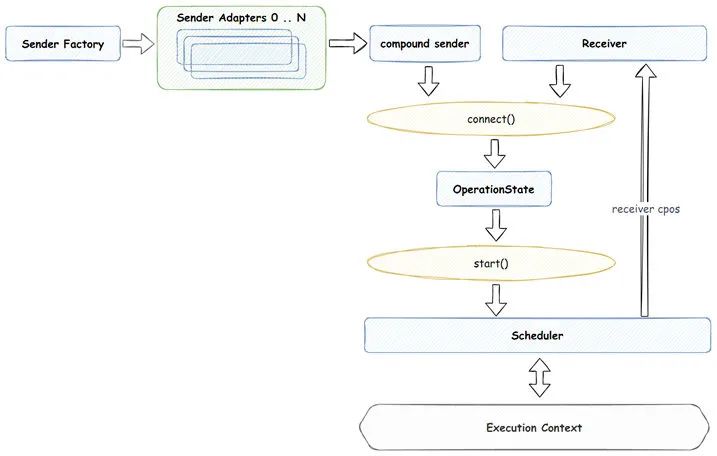
|运算符来做到这一点, 而 executions 因为本身的复杂度基于 CPO 引入了更复杂的tag invoke机制, 来组织自己的 DSL, 因为这种表达代码层面有很高的复杂度, 也被社区广泛的戏称为 "存在大量的代码噪声", 或者说开发了一种"方言". 但不可否认, 通过引入底层的 DSL 支撑特性, executions 很好的实现了结构化并发.
目前我们可以参考学习的工程化实践, 主要是 Meta 公司开发的 libunifex 库, 在结构化并发这部分, libunfix 其实已经做得比较好了, 但其本身是存在一些缺陷的, 一方面, libunifex 的调度器实现相比 asio, 还存在很大的落差, 另外, 一些支持工程应用的算法也有很多的缺失, 需要更长周期的发展和稳定.
所以对此, 我们目前的策略是保持预研的状态, 在实现上尝试将 libunifex 的调度器更多的结合 asio 的调度器, 并实现一些我们工程化比较急需的算法, 逐步引入 executions 的结构化并发, 对异步进行更好的开发与管理. 但不可否认的是, 目前综合来看, executions 的成熟度和易用性都远远比不上 C++ Coroutine20, 短时间来看, 还是基于 Coroutine 的异步框架更值得投入.
协程部分的特性目前是作为我们自研引擎框架能力的一部分提供的, 一方面我们会围绕 Coroutine 以及 Scheduler 补齐更多相关的特性, 如前面说到的对复合的异步任务的支持等, 另外我们也会尝试一些 Executions 相关的探索, 如异构并发支持等, 相信随着标准的进一步发展, 越来越多的人对这块的投入和尝试, 整个 C++的异步会向着使用侧更简洁, 表达能力更强的方向进化.
本文由哈喽比特于2年以前收录,如有侵权请联系我们。
文章来源:https://mp.weixin.qq.com/s/QVXE7QbxEchl8ue4SoijiQ
京东创始人刘强东和其妻子章泽天最近成为了互联网舆论关注的焦点。有关他们“移民美国”和在美国购买豪宅的传言在互联网上广泛传播。然而,京东官方通过微博发言人发布的消息澄清了这些传言,称这些言论纯属虚假信息和蓄意捏造。
日前,据博主“@超能数码君老周”爆料,国内三大运营商中国移动、中国电信和中国联通预计将集体采购百万台规模的华为Mate60系列手机。
据报道,荷兰半导体设备公司ASML正看到美国对华遏制政策的负面影响。阿斯麦(ASML)CEO彼得·温宁克在一档电视节目中分享了他对中国大陆问题以及该公司面临的出口管制和保护主义的看法。彼得曾在多个场合表达了他对出口管制以及中荷经济关系的担忧。
今年早些时候,抖音悄然上线了一款名为“青桃”的 App,Slogan 为“看见你的热爱”,根据应用介绍可知,“青桃”是一个属于年轻人的兴趣知识视频平台,由抖音官方出品的中长视频关联版本,整体风格有些类似B站。
日前,威马汽车首席数据官梅松林转发了一份“世界各国地区拥车率排行榜”,同时,他发文表示:中国汽车普及率低于非洲国家尼日利亚,每百户家庭仅17户有车。意大利世界排名第一,每十户中九户有车。
近日,一项新的研究发现,维生素 C 和 E 等抗氧化剂会激活一种机制,刺激癌症肿瘤中新血管的生长,帮助它们生长和扩散。
据媒体援引消息人士报道,苹果公司正在测试使用3D打印技术来生产其智能手表的钢质底盘。消息传出后,3D系统一度大涨超10%,不过截至周三收盘,该股涨幅回落至2%以内。
9月2日,坐拥千万粉丝的网红主播“秀才”账号被封禁,在社交媒体平台上引发热议。平台相关负责人表示,“秀才”账号违反平台相关规定,已封禁。据知情人士透露,秀才近期被举报存在违法行为,这可能是他被封禁的部分原因。据悉,“秀才”年龄39岁,是安徽省亳州市蒙城县人,抖音网红,粉丝数量超1200万。他曾被称为“中老年...
9月3日消息,亚马逊的一些股东,包括持有该公司股票的一家养老基金,日前对亚马逊、其创始人贝索斯和其董事会提起诉讼,指控他们在为 Project Kuiper 卫星星座项目购买发射服务时“违反了信义义务”。
据消息,为推广自家应用,苹果现推出了一个名为“Apps by Apple”的网站,展示了苹果为旗下产品(如 iPhone、iPad、Apple Watch、Mac 和 Apple TV)开发的各种应用程序。
特斯拉本周在美国大幅下调Model S和X售价,引发了该公司一些最坚定支持者的不满。知名特斯拉多头、未来基金(Future Fund)管理合伙人加里·布莱克发帖称,降价是一种“短期麻醉剂”,会让潜在客户等待进一步降价。
据外媒9月2日报道,荷兰半导体设备制造商阿斯麦称,尽管荷兰政府颁布的半导体设备出口管制新规9月正式生效,但该公司已获得在2023年底以前向中国运送受限制芯片制造机器的许可。
近日,根据美国证券交易委员会的文件显示,苹果卫星服务提供商 Globalstar 近期向马斯克旗下的 SpaceX 支付 6400 万美元(约 4.65 亿元人民币)。用于在 2023-2025 年期间,发射卫星,进一步扩展苹果 iPhone 系列的 SOS 卫星服务。
据报道,马斯克旗下社交平台𝕏(推特)日前调整了隐私政策,允许 𝕏 使用用户发布的信息来训练其人工智能(AI)模型。新的隐私政策将于 9 月 29 日生效。新政策规定,𝕏可能会使用所收集到的平台信息和公开可用的信息,来帮助训练 𝕏 的机器学习或人工智能模型。
9月2日,荣耀CEO赵明在采访中谈及华为手机回归时表示,替老同事们高兴,觉得手机行业,由于华为的回归,让竞争充满了更多的可能性和更多的魅力,对行业来说也是件好事。
《自然》30日发表的一篇论文报道了一个名为Swift的人工智能(AI)系统,该系统驾驶无人机的能力可在真实世界中一对一冠军赛里战胜人类对手。
近日,非营利组织纽约真菌学会(NYMS)发出警告,表示亚马逊为代表的电商平台上,充斥着各种AI生成的蘑菇觅食科普书籍,其中存在诸多错误。
社交媒体平台𝕏(原推特)新隐私政策提到:“在您同意的情况下,我们可能出于安全、安保和身份识别目的收集和使用您的生物识别信息。”
2023年德国柏林消费电子展上,各大企业都带来了最新的理念和产品,而高端化、本土化的中国产品正在不断吸引欧洲等国际市场的目光。
罗永浩日前在直播中吐槽苹果即将推出的 iPhone 新品,具体内容为:“以我对我‘子公司’的了解,我认为 iPhone 15 跟 iPhone 14 不会有什么区别的,除了序(列)号变了,这个‘不要脸’的东西,这个‘臭厨子’。









